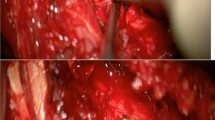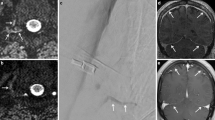Summary
Head injurries are sometimes complicated by cerebrospinal fluid rhinorrhoea. The exact localisation of the fistula is indispensable in cases requiring surgery. This may be achieved by visualization of the fistula with radiopaque substance introduced via the lumbar route and brought into the cranial cavity. This method was successfully used in the case reported here.
Résumé
Les traumatismes crâniens se compliquent parfois de rhinorrhée céphalo-rachidienne. Il est indispensable de connaître la localisation exacte de la fistule dans les cas nécessitant une intervention chirurgicale. Ceci peut être réalisé par la mise en évidence de la fistule grâce à un produit radio-opaque introduit par voie lombaire et dirigé dans la cavité crânienne. Cette méthode a été utilisée avec succès dans le cas rapporté.
Zusammenfassung
Nach lumbaler Injektion von 3 ml Pantopaque wurde das Kontrastmittel unter Röntgenkontrolle in den Schädelinnenraum und zu der Region der vermuteten Liquor-Fistel geleitet. Es gelang ein eindeutiger Nachweis der Frakturstelle.
Similar content being viewed by others
References
Jungman, A., Peyser, E.: Roentgen visualization of cerebrospinal fluid fistula with contrast medium. Radiology 80, 92–95 (1963).
Bronson, S. Ray, Bergland, R.M.: Cerebrospinal fluid fistula: clinical aspects, technics of localisation and methods of closure. J. Neurosurg. 30, 399–405 (1969).
Straus, D.C.: Intracranial pneumocephalus; report of a case. Arch. Surg. 56, 766–784 (1948).
Ghouralal, S., Myers, P.W., Campbell, E.: Persistent CSF rhinorrhea originating in fracture through petrous bone and cured by muscle graft: report of a case. J. Neurosurg. 13, 205–207 (1956).
Teng, P., Edalatpour, N.: Cerebrospinal fluid rhinorrhea with demonstration of cranionasal fistula with pantopaque. Radiology 81, 802–806 (1963).
Rocket, F.X., Wittemborg, M.H., Shillito, Jr., J., Matson, D.D.: Pantopaque visualization of a congenital dural defect of the internal auditory meatus causing rhinorrhea. Report of a case. Amer. J. Roentgenol. 91, 640–646 (1964).
Di Chiro, G., Ommaya, A.K., Ashburn, W.L.: Isotope cisternography in the diagnosis and follow up of cerebrospinal fluid rhinorrhea. J. Neurosurg. 28, 522–529 (1968).
Detmer, D.E., Blacker, H.M.: A case of aseptic meningitis secondary to intrathecal injection of I131 human serum albumin. Neurology (Minneap.) 15, 642–643 (1965).
Nicol, C.F.: A second case of aseptic meningitis following isotope cisternography using I131 human serum albumin. Neurology, (Minneap.) 17, 199–200 (1967).
Author information
Authors and Affiliations
Rights and permissions
About this article
Cite this article
Doron, Y., Simon, J. & Peyser, E. Positive contrast myeloencephalography for visualization of cerebrospinal fluid fistula. Neuroradiology 3, 228–230 (1972). https://doi.org/10.1007/BF00339958
Issue Date:
DOI: https://doi.org/10.1007/BF00339958




